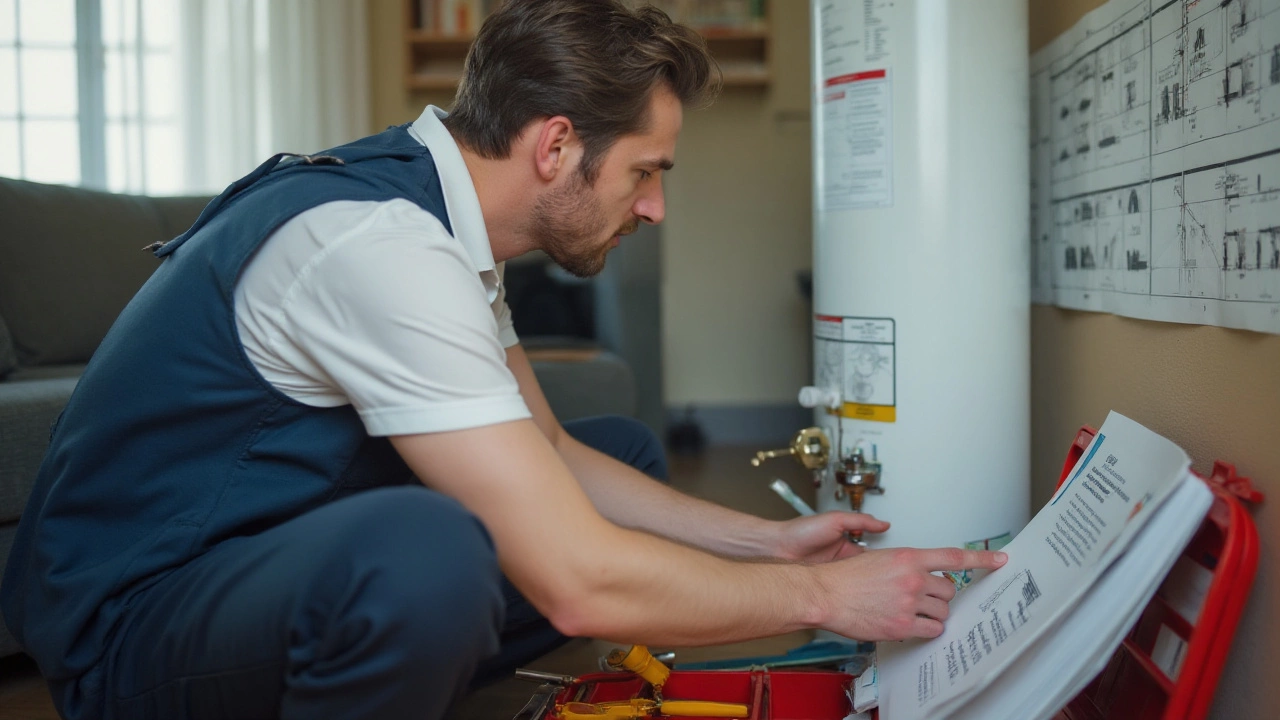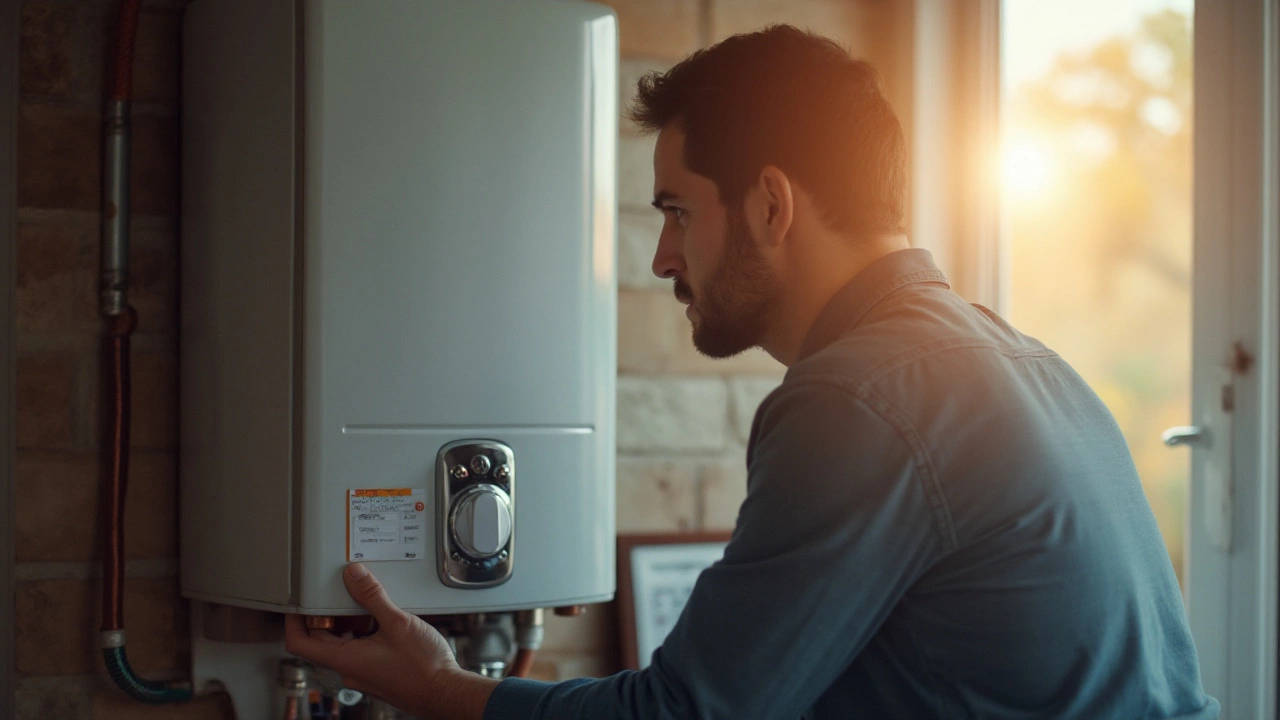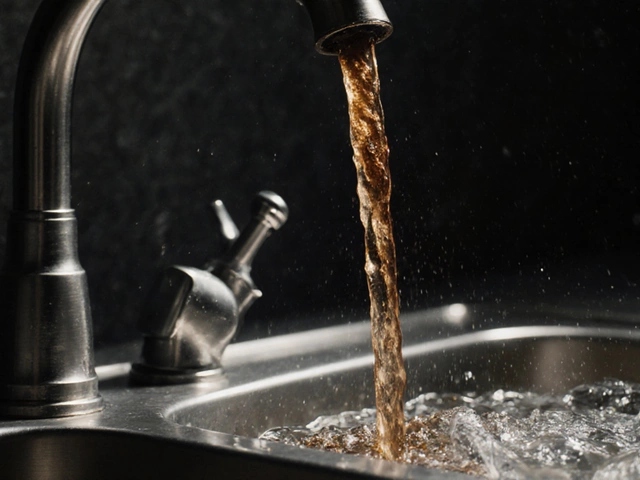Resetting a water heater is a seemingly simple act that many homeowners turn to when experiencing heating issues. But frequently reaching for that reset button could be a sign of more severe problems lurking within your heating system. Understanding these signals can help prevent costly repairs or replacements.
This article will delve into the various reasons why you might need to reset your water heater often, and the potential dangers of ignoring these signs. We'll guide you through identifying common problems and offer practical tips for troubleshooting. Additionally, knowing when to call in the experts and how regular upkeep can prolong your water heater’s life will be discussed. Let's ensure your water heating system runs smoothly and efficiently.
- Why Water Heaters Need Resetting
- Potential Risks from Frequent Resets
- Common Underlying Problems
- DIY Troubleshooting Tips
- When to Call a Professional
- Maintenance for Longevity
Why Water Heaters Need Resetting
Every homeowner who has ever been forced to take an unexpected cold shower knows the panic that ensues when a water heater fails. While pressing the reset button may seem like a quick remedy, it's crucial to understand why it might be happening repeatedly. Resetting a water heater frequently is not just an inconvenience; it usually indicates something far more profound. This button, known technically as the high-limit switch, serves as an essential safety feature. When the water inside the tank becomes excessively hot, surpassing safe limits, this switch automatically shuts off power to prevent hazardous overheating. This is the heater's way of protecting itself and your household from potential burns or even more severe incidents like fires.
Sustained resetting issues often point to a malfunctioning thermostat. The thermostat regulates the temperature of the water, ensuring it remains within the prescribed limits. If defective, it might not register the correct water temperature, causing the heating element to run uncontrollably. This leads the high-limit switch to perform its protective function. Another reason could be sediment buildup at the bottom of the tank, leading to overheating. Over time, minerals from hard water collect inside the tank, creating an insulating barrier. This sedimentary layer requires the heating element to work harder for longer hours to heat the water effectively, causing frequent tripping of the reset button.
In some cases, electrical issues could be the root of the problem. Loose wiring or a failing component within the heating system may intermittently cause power surges, triggering the high-limit switch. It's worth noting that wiring issues are not the kind one should tackle without professional assistance. Moreover, the age of the heater might also be contributing to this need for constant resetting. Older models extensively wear out, needing more effort to maintain desired temperatures. According to a study by Consumer Reports, most water heaters need replacement every 10-15 years due to efficiency loss and safety concerns.
In a 2022 survey by the Water Quality Association, around 20% of homeowners experienced frequent water heater malfunctions due to neglected maintenance. This statistic underlines the importance of regular inspections and proper upkeep. Not addressing these causes might not only result in a full breakdown of your water heater but also inflate your energy bill. A water heater striving to maintain a consistent temperature works harder and consumes more power, which reflects directly in increased energy consumption costs.
"Understanding your energy appliance's needs is key to avoiding unexpected failures," suggests a report by the International Association of Professional Contractors. "Routine checks are an investment versus an unexpected expense."
Potential Risks from Frequent Resets
When you find yourself continuously resetting your water heater, it's crucial to recognize this as a red flag rather than a minor inconvenience. One primary risk associated with frequent resets is the potential for overheating. The thermostat might be faulty, leading to unsafe water temperatures. Overheated water can increase the risk of scalding, which is particularly dangerous for children and the elderly. Additionally, the excessive heat puts more stress on the heating system parts, significantly reducing their lifespan and efficiency.
Another pressing concern is the risk of electrical hazards. If the reset button keeps tripping, it could mean there's a more significant electrical fault. This might include faulty wiring or a malfunctioning heating element, both of which pose a serious fire hazard. In fact, reports have shown that a considerable portion of home electrical fires each year result from appliance malfunctions, with water heaters being a notable culprit. As such, handling electrical issues promptly and appropriately can be lifesaving.
A study by the Electrical Safety Foundation International highlights that proper maintenance and timely identification of appliance issues can prevent about 70% of electrical fires.
Beyond immediate dangers, regular resets can also lead to increased wear and tear on key components. The reset process itself is not inherently damaging, but the underlying issues causing these resets can lead to accelerated deterioration of parts like the heating system, thermostats, and elements. As these parts fail prematurely, you might face expensive repairs or even the need for a complete replacement of the heater.
Constantly resetting your heater can also impact your utility bills. A malfunctioning heater often works overtime to compensate for its inability to maintain a stable temperature. This excess energy use translates directly into increased electricity or gas bills. An inefficient system struggles to convert energy into heat effectively, causing your bills to skyrocket while depriving you of the desired comfort level at home.
If left unchecked, these problems can spiral into more catastrophic failures. An impaired pressure relief valve, for instance, can escalate into an explosion risk if temperatures or pressure are not correctly regulated. Ensuring the integrity of safety mechanisms like this valve is essential in protecting your home from destructive, preventable incidents.
In summary, repeatedly resetting your water heater is more than just a temporary fix; it's a signal of more profound, often invisible issues with potentially severe consequences. Taking proactive steps to address these problems not only safeguards your household but also maintains the efficiency and effectiveness of your heating system over the long haul.

Common Underlying Problems
Constant resetting of your water heater often indicates deeper issues within the system. It's much like hitting the snooze button on a clock; it may offer temporary relief, but it soon becomes evident that something more significant needs addressing. One possible culprit is a faulty thermostat. When the thermostat fails, it can cause the water to overheat or not heat properly, leading to the safety mechanism tripping the reset button. This safety feature is designed to prevent potential hazards, thus highlighting the vital role thermostats play in your heating system.
Another common issue is sediment build-up within the tank. This is especially problematic in areas with hard water, as minerals like calcium and magnesium can accumulate at the bottom of the tank over time. This sediment layer can insulate the water from the heating element, causing the heater to work harder and longer, eventually triggering the reset due to overheating. Regular flushing can mitigate this build-up, an essential step often overlooked in routine maintenance.
Let's not forget electrical issues. Faulty wiring or connections can intermittently cut power, causing the circuit breaker to trip. Such issues are not just inconvenient; they can be dangerous, posing risks of short circuits or even fires. Addressing electrical faults requires skilled intervention. A qualified electrician can ensure all connections are secure and components are functioning correctly, safeguarding your home and ensuring the reliability of your heating system.
Heating element failures are also noteworthy. Over time, these essential components can wear out, especially if they're continually overworked due to issues like sediment insulation. When a heating element fails, it ceases to heat water efficiently, which can eventually trip the reset button as the system attempts to compensate for inadequate heating. Replacing these elements often resolves the problem and restores the unit's efficiency.
"Understanding the signs of underlying problems with your water heater prevents small issues from blossoming into major disasters." – Home Maintenance Experts JournalIt's also worth checking the pressure relief valve. This component ensures excess pressure or temperature within the tank can safely escape. If it's malfunctioning, pressure can build to dangerous levels, triggering the reset as a precaution to prevent possible tank failure or ruptures.
To conclude, frequent resets shouldn't be ignored. They signal that something isn't right within your heating system. By identifying and addressing these underlying problems, you not only extend the lifespan of your water heater but also enhance its efficiency and safety. Understanding these potential issues is crucial for any homeowner aiming to maintain a proficient and responsive water heating system in their residence.
DIY Troubleshooting Tips
Tackling water heater issues yourself can sometimes be more straightforward than it might seem, offering both a sense of accomplishment and savings on professional fees. Before diving into complex fixes, it’s crucial to start with some basic checks. Often, the simplest fixes can resolve the most persistent problems. For instance, assuring that the power supply to the unit is steady and uninterrupted is a good first step. Many water heaters have a dedicated circuit, and it’s wise to inspect the circuit breaker to ensure it's not tripped. In case it has, resetting the breaker might just resolve the issue.
Next, take a close look at the thermostat settings. Incorrect thermostat settings can easily lead to inadequate water temperatures, prompting unnecessary resets in attempt to solve the problem. Adjusting the thermostat to the recommended setting—usually around 120°F for efficiency and safety—can make a significant difference. Should the problem persist, inspecting the unit for any obvious signs of leaks around the edges or from the pressure relief valve is a sound next step. Leakage can not only affect performance but also lead to further damage if ignored.
If visual inspection doesn’t yield answers, you can dig further into diagnosing the issues with some basic tools. A malfunctioning heating element or a thermostat that no longer functions correctly can often result in abrupt water heater shut-offs. Using a multimeter, a simple tool available at most hardware stores, these components can be tested for continuity. A reading of zero or infinity signifies the need for replacement. Caution is key, though, and ensuring the power is turned off before any testing attempts is essential to avoid hazards.
"Homeowners should have a basic understanding of their appliances. Using tools like a multimeter can empower them to perform simple diagnostics, potentially saving on costly service calls." - The Spruce, Home Improvement Expert.Another crucial aspect to consider is sediment build-up in your water heater’s tank. It’s a lesser-known fact, but sediment can accumulate over time from the minerals in hard water, affecting the efficiency and longevity of the heating elements. Flushing your water heater tank is a straightforward yet effective maintenance step. By turning off the water heater, connecting a hose to its drain valve, and flushing out the system, a significant amount of sediment can be cleared, potentially restoring your unit's efficiency and preventing unnecessary resets.
Heating system issues may sometimes seem daunting, but with a little perseverance and the right tools, it’s possible to diagnose and fix simpler problems without resorting to professional help. However, it’s pivotal to understand when a problem surpasses the realm of DIY fixes. Regular sensations of electric shocks from inconsistent grounding or persistent problems that aren’t solvable with above steps warrant professional intervention. Reaching out to a licensed technician can ensure a more detailed inspection and repair, ensuring your system’s longevity and your peace of mind.

When to Call a Professional
Every homeowner faces the dilemma of whether to tackle an issue themselves or bring in a professional. With a water heater, this decision becomes crucial, given the potential hazards and complexities involved. A solid understanding of when to step back and reach out for expert help is essential. If your heater frequently trips the reset button despite performing basic troubleshooting, it's a tell-tale sign of deeper electrical or mechanical issues. These scenarios demand professional attention to prevent further damage or safety risks.
Another instance where calling an expert becomes non-negotiable is when you notice leaks around the unit. Leaks might seem minor at first, but they can indicate significant issues such as a corroded tank or failed gaskets. These problems, if left unchecked, can escalate into costly replacements or extensive water damage to your home. A professional is equipped with the tools and expertise to diagnose and fix such problems efficiently.
If you encounter unusually noisy operation originating from the water heater, it might suggest sediment buildup, loose heating elements, or even a faulty heating system. While some homeowners might consider handling these issues themselves, proper diagnosis and intervention require a professional's knowledgeable touch. Incorrect handling can exacerbate the problem, risking further damage or voiding warranties.
One less obvious yet crucial sign you need a professional is irregular water temperatures or a complete lack of hot water. This issue could stem from thermostat malfunctions, broken heating elements, or wiring problems. An expert is trained to safely navigate and rectify these faults, often using diagnostic tools unavailable to the average homeowner. Moreover, professionals can ensure work complies with safety regulations and is done efficiently, saving you time and potential hazard.
According to the Plumbing Manufacturers International, "Routine maintenance and timely professional intervention are key to extending the lifespan of your water heater."Moreover, if you've already attempted several resets without resolving the issue, it's time to contact a professional. Repeated resetting stresses the system, leading to premature wear and tear. Professionals are trained to identify if an issue is repairable or if replacement is a more cost-effective solution.
Finally, when a water heater is nearing the end of its lifespan—typically 8 to 12 years—a professional should evaluate whether it's time for an upgrade. They can provide guidance on energy-efficient models that could save you money in the long run. Their product knowledge ensures that you invest in a water heater compatible with your home’s needs, optimized for your household's size and energy consumption.
Maintenance for Longevity
A well-maintained water heater not only delivers uninterrupted service but also works more efficiently, saving you both time and money. To ensure your water heater stands the test of time, adopting a routine maintenance schedule is key. One crucial step is to regularly check the temperature setting on your water heater. Ideally, the thermostat should be set to about 120 degrees Fahrenheit. This helps to avoid scalding while also minimizing energy use.
Flushing the tank is another key maintenance task that helps in removing sediment build-up, which can cause the tank to corrode faster than normal. To flush your water heater, you should start by turning off the water supply and the power source. Attach a hose to the tank’s drain valve and let the water drain until it runs clear. This process helps maintain a clean system and improves efficiency.
Insulating the water heater and the first few feet of pipe is also a great step towards reducing heat loss and improving efficiency. Wrapping both the heater and the pipes with a specialized insulating blanket keeps the water at the desired temperature longer, reducing energy spend. Remember, a cooler tank exterior also means less work for your heater over time.
Checking the anode rod should be part of your routine inspections. The anode rod, or 'sacrificial rod', is essential in protecting the tank from rusting. This rod attracts corrosive particles to it rather than to your heater walls. Over time, the rod will corrode and need to be replaced, typically every few years. A glance should be enough to see if the rod is less than ½ inch thick or covered in calcium build-up, signaling it’s time for a replacement.
According to a report from the Department of Energy, "Timely maintenance can extend water heater lifespan by as much as 12 to 15 years." Regular check-ups also help in early detection of potential problems before they become costly repairs.
Finally, consider investing in a maintenance service plan with a qualified technician. Although performing these steps yourself helps, having a professional inspect and tune your system yearly can identify and rectify any minor issues before they escalate.
By staying ahead with these maintenance tips, your heating system should function smoothly for years to come. Not only will it cut down on unexpected resets, but it also ensures you get what you paid for in terms of performance and durability.





